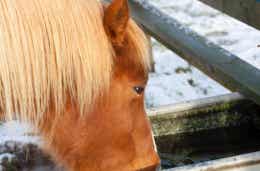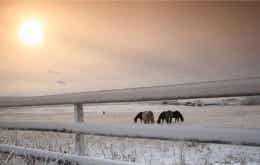FIGHT THE COLD: FEEDING DURING THE WINTER
Dr. Stephen Duren and Dr. Tania Cubitt, Performance Horse Nutrition

During the winter season, temperatures typically fall below what is necessary for pasture grass to grow. Pastures become rapidly depleted of natural forage and horses must increasingly rely on their owners to provide them with a nutritionally adequate diet. To properly feed a horse during the winter months several key factors must be addressed. These factors are water, fiber and essential nutrients.
Water should always be the first consideration in the diet for any horse. Without adequate water intake horses will not survive. An adult horse (1000 lbs.) in a cool, comfortable environment that is not working or lactating requires a minimum of 7 - 10 gallons of fresh clean water per day. The amount of water required is closely related to the amount of feed eaten. Most horses will drink 1.5 quarts of water per pound of dry feed intake. If a horse were consuming 20 lbs. of dry hay per day, the horse would be expected to consume approximately 7.5 gallons of water per day. The water requirement is higher if the horse is in training, nursing a foal, growing, pregnant or in a hot/ humid environment. The best situation to ensure adequate water intake is to provide free access to fresh clean water.
Problems associated with water intake during the winter months usually revolve around inadequate intake. Water that has frozen or is near freezing will result in decreased intake. Similarly, horses that must eat snow, as their only water source, will not eat enough snow to completely satisfy their water requirement. This decreased water intake can result in digestive upset or “colic” that is associated with feed material becoming impacted (stuck) in the digestive system. Therefore, the water source should be free-flowing or heated to prevent freezing and guarantee adequate intake. When installing a heating device for water, be sure any electrical unit is properly grounded to prevent electrical shock of the horse. Horses are very sensitive to electrical shock and will quit drinking to avoid shock.
Adequate fiber intake is the next consideration in feeding horses during the winter season. It is recommended that horses receive a minimum of 1.5% of their body weight in dry forage per day. For a 1000 lb. horse, this equates to 15 lbs. of hay per day. Can horses consume more hay? Certainly, horses can consume up to 3% of the body weight per day in hay (30 lbs. for a 1000-lb. horse) if the hay is of good quality. The fiber obtained from hay is necessary to keep the digestive system of the horse functioning properly. Without this hay fiber, horses will seek out other sources of fiber including bedding and wood fences or trees to satisfy their needs. Adequate fiber from hay is even more critical during the winter months since it is the feed ingredient that keeps horses warm during cold weather. Digestion and fermentation of fiber (hay) produce heat that helps the horse maintain its body temperature during winter. Unlike hay, consumption of grain does not produce large amounts of body heat during digestion. Grain functions to keep horses warm by providing energy for muscle contraction that can be used to help the animal shiver. Therefore, the best way to keep horses warm during cold weather is to provide plenty of good quality hay.
When environmental temperatures (including wind chill) drop below 45°F (referred to as the critical temperature), significant amounts of energy are used by the horse to maintain its internal body heat. For each 1°F decrease below the critical temperature, the horse requires a 1% increase in digestible energy to maintain a consistent body temperature. Wind chill, moisture, and coat thickness will affect the critical temperature. The horse’s thick winter coat has an insulating effect against cold and wind. If the coat becomes wet, the critical temperature will increase by 10 to 15°F.

Increase the forage content of the diet 24 hours prior to forecasted cold conditions. Strive to keep your horse in a good body condition prior to winter months as the extra body fat provides an additional insulating effect against wind and also serves as an energy reserve.
A frequent hay related problem with horses during the winter months is chronic weight loss. This can occur either by not feeding enough hay to the horse, or by feeding poor quality hay to the horse. In both cases the horse will have trouble getting enough calories from the hay to maintain body weight. In the case of not feeding enough hay, the simple remedy is to provide all the hay the horse will consume during the day. If the horse is being fed all the hay it will consume and weight loss is still a problem, better quality hay or forage should be substituted for all or part of the current hay source. Better quality hays are typically higher calorie hays such as alfalfa compared to grass hay. Other baled hay or forage substitutes, such as cubes or pellets can be fed to replace poor quality hay. Standlee Premium Products offers a wide variety of Alfalfa and Alfalfa mix products ranging from baled forage, to cubes, pellets and chopped forage. Also available are beet pulp shreds and pellets that increase the calorie content of the forage portion of the diet and are highly digestible.

